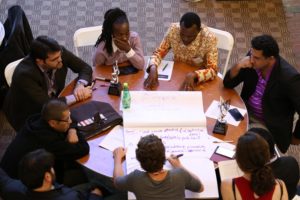Minds of the Movement
An ICNC blog on the people and power of civil resistance
by Hardy MerrimanApril 30, 2018
Defining What a Movement Is
There’s a growing effort among human rights funders and organizations to focus on supporting grassroots movements around the world. This trend is rooted in recognition that movements often play an essential role in making social, political, and economic change; that traditional models of human rights funding and support are coming under greater pressure by governments; and that alternative models of change and support are needed.
An emphasis on movements is a positive development, yet underlying these general perspectives, the specifics can get vague. For example:
• How exactly does one define the term “movement”?
• What is the specific process by which movements make change?
• What does a movement-centered support model look like?
For the last 16 years, my organization, the International Center on Nonviolent Conflict (ICNC), has focused our work on increasing understanding and sharing knowledge about the dynamics of nonviolent civil resistance movements and how they can be made more effective, worldwide. As a private operating foundation, we lead our own programs and also write grants to support grassroots education as well as research in this field.
This series of blog posts will address some key aspects of our model and lessons learned. My first post will focus on movements, which we define as follows:
Ongoing collective efforts aimed at bringing about consequential change in a social, economic, or political order. Movements are civilian-based, involve widespread voluntary popular participation, and alert, educate, serve, and mobilize people in order to create change.1 (emphasis added)
The above is not the only definition of this term; indeed, social scientists and others have debated this issue for decades, and movements are particularly difficult to define at their edges (i.e. where and when does a movement begin and end?). But this definition has served us well, and may be a useful starting point for others to discuss and adapt as they see fit.

Movement participants and others learning how to alert, educate, serve, and mobilize people at the 2016 ICNC Summer Institute. Source: ICNC.
There are several key implications from this definition, and I’ve highlighted some points of emphasis.
First, movements are ongoing. They persist over time. A quick mass mobilization that fizzles out, or a trending social media hashtag or topic, does not by itself signify a movement. A crowd of people mobilizing is not by itself a movement. The first time we see mobilization in a particular place, we often can’t be sure if it will become a movement or not.
Second, movements are civilian-based, and aim to make consequential change through widespread voluntary popular participation. This means that movements exist and exercise power through the engagement and efforts of “ordinary” people (by which I mean, people who don’t have any special status, title, or privilege). Unlike more hierarchical organizations, most movements can’t be commanded and controlled from the top down, because if people disagree with the actions of a movement’s leaders, they may vote with their feet and simply refuse to participate. This issue of voluntary participation, and how it is elicited and maintained, is an essential aspect in our understanding of movements, and informs our efforts and expectations about how we engage in our work to support them.
Because a movement is dependent on popular participation, it is not the same as an organization. Elites and organizations may be part of a movement, and may even play leading roles, if they are supported through the participation of many (often thousands or even millions) of people. But it’s important to also draw a line: under our definition, top-down efforts and NGO coalitions (even if they’re grassroots NGOs) that don’t elicit widespread popular participation are not movements. Labor unions that turn out only their members to mobilize, without mobilizing people in the broader public, are also not movements. The term is too frequently misapplied and used for too many purposes. It’s important to recognize that not every effort that calls itself a “movement” necessarily is a movement, depending on one’s definition.
Lastly, what are the functions of movements? They alert, educate, serve, and mobilize people.
Alert means that movements force issues onto the public agenda that have often been neglected or suppressed, and they keep those issues in the public mind.
The educational function of movements is critical—by reaching out to ordinary people and gaining their participation, movements deepen understanding of root causes of problems and potential solutions, link people and issues across geographies and demographics, and build skills (i.e. group decisionmaking, organizing, strategizing, and communications) among their supporters. Through the process of movement participation, people often realize how their personal stories and circumstances are connected to the stories and circumstances of others, and those who have been alienated from the traditional political system realize that politics can be practiced in a different way through their efforts in the movement.
A further function of movements is serving people, and this can take many forms. Certainly some movements materially assist people—for example, by providing food or services to their supporters—although not all movements have the resources to do this. But all movements serve the psychological needs of their supporters. A movement can be thought of as a community, and communities thrive when they create bonds between people; when they give a sense of purpose, meaning, and dignity to people’s lives. They also often offer a sense of identity and belonging. As such, it’s not surprising that one of the best predictors of someone joining a movement is if they know others who are already engaged with the movement.
Furthermore, the way a movement serves people does not always need to be defined based on a clear “in group” and “out group”. Some movements may have a more defined in/out line, but for others, having softer edges creates a low barrier to entry for those who want to participate in minimal ways, or who, by virtue of their life circumstances (i.e. family breadwinner or caretaker without much time, or people with little tolerance for risk), need to be able to flow in or out of a movement as their situation dictates.
Lastly, movements mobilize people. What’s the image that comes to mind when you think of a movement mobilizing? Chances are, it’s the image of a protest. And in fact, some people think movements are primarily about protest, which misses some of the other critical functions and aspects of their work. As we will see, movement mobilization can take many forms, and movements can activate different models of change. I’ll address a powerful model in my next post defining “civil resistance”, and discussing how civil resistance works.
1 This definition draws from:
John McCarthy, “Social Movements” in Powers, Vogele, Kruegler, and McCarthy (eds.), Protest, Power, and Change, New York: Garland Publishing, 1997.
Bill Moyer, Doing Democracy, Gabriola Island, BC: New Society Publishers, 2001.
Kurt Schock, Unarmed Insurrections, Minneapolis, MN: University of Minnesota Press, 2005.

Hardy Merriman
Hardy Merriman is President of the International Center on Nonviolent Conflict (ICNC), and led ICNC as President & CEO from 2015 until 2021. He has worked in the field of civil resistance for over 20 years, presenting at workshops for activists and organizers; speaking widely to scholars, journalists, and members of international organizations; and developing educational resources.
Read More